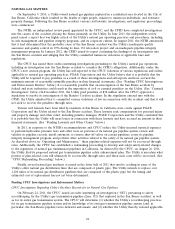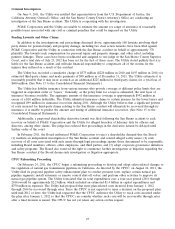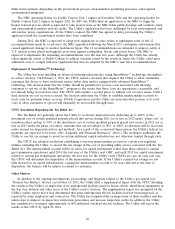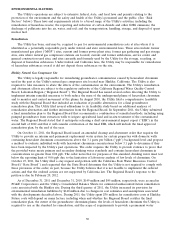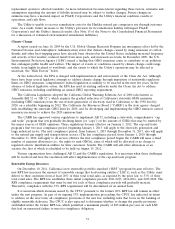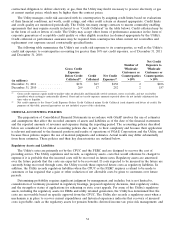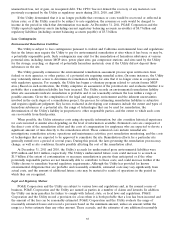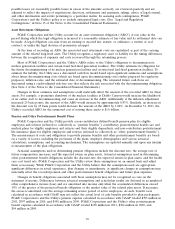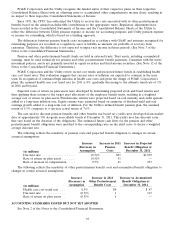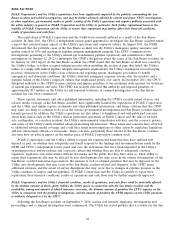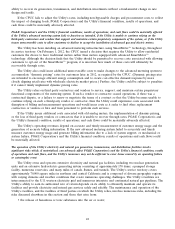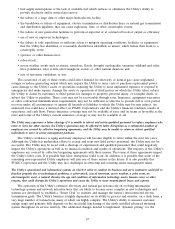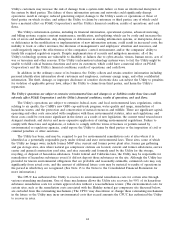PG&E 2011 Annual Report Download - page 38
Download and view the complete annual report
Please find page 38 of the 2011 PG&E annual report below. You can navigate through the pages in the report by either clicking on the pages listed below, or by using the keyword search tool below to find specific information within the annual report.
contractual obligation to deliver electricity or gas, then the Utility may find it necessary to procure electricity or gas
at current market prices, which may be higher than the contract prices.
The Utility manages credit risk associated with its counterparties by assigning credit limits based on evaluations
of their financial conditions, net worth, credit ratings, and other credit criteria as deemed appropriate. Credit limits
and credit quality are monitored periodically. The Utility ties many energy contracts to master commodity enabling
agreements that may require security (referred to as ‘‘Credit Collateral’’ in the table below). Credit collateral may be
in the form of cash or letters of credit. The Utility may accept other forms of performance assurance in the form of
corporate guarantees of acceptable credit quality or other eligible securities (as deemed appropriate by the Utility).
Credit collateral or performance assurance may be required from counterparties when current net receivables and
replacement cost exposure exceed contractually specified limits.
The following table summarizes the Utility’s net credit risk exposure to its counterparties, as well as the Utility’s
credit risk exposure to counterparties accounting for greater than 10% net credit exposure, as of December 31, 2011
and December 31, 2010:
Net Credit
Number of Exposure to
Gross Credit Wholesale Wholesale
Exposure Customers or Customers or
Before Credit Credit Net Credit Counterparties Counterparties
Collateral(1) Collateral Exposure(2) >10% >10%
(in millions)
December 31, 2011 .............. $151 $13 $138 2 $106
December 31, 2010 .............. 269 17 252 2 187
(1) Gross credit exposure equals mark-to-market value on physically and financially settled contracts, notes receivable, and net receivables
(payables) where netting is contractually allowed. Gross and net credit exposure amounts reported above do not include adjustments for
time value or liquidity.
(2) Net credit exposure is the Gross Credit Exposure Before Credit Collateral minus Credit Collateral (cash deposits and letters of credit). For
purposes of this table, parental guarantees are not included as part of the calculation.
CRITICAL ACCOUNTING POLICIES
The preparation of Consolidated Financial Statements in accordance with GAAP involves the use of estimates
and assumptions that affect the recorded amounts of assets and liabilities as of the date of the financial statements
and the reported amounts of revenues and expenses during the reporting period. The accounting policies described
below are considered to be critical accounting policies due, in part, to their complexity and because their application
is relevant and material to the financial position and results of operations of PG&E Corporation and the Utility, and
because these policies require the use of material judgments and estimates. Actual results may differ substantially
from these estimates. These policies and their key characteristics are outlined below.
Regulatory Assets and Liabilities
The Utility’s rates are primarily set by the CPUC and the FERC and are designed to recover the cost of
providing service. The Utility capitalizes and records, as regulatory assets, costs that would otherwise be charged to
expense if it is probable that the incurred costs will be recovered in future rates. Regulatory assets are amortized
over the future periods that the costs are expected to be recovered. If costs expected to be incurred in the future are
currently being recovered through rates, the Utility records those expected future costs as regulatory liabilities. In
addition, the Utility records regulatory liabilities when the CPUC or the FERC requires a refund to be made to
customers or has required that a gain or other reduction of net allowable costs be given to customers over future
periods.
Determining probability requires significant judgment by management and includes, but is not limited to,
consideration of testimony presented in regulatory hearings, proposed regulatory decisions, final regulatory orders,
and the strength or status of applications for rehearing or state court appeals. For some of the Utility’s regulatory
assets, including the regulatory assets for ERBs and utility retained generation, the Utility has determined that the
costs are recoverable based on specific approval from the CPUC. The Utility also records a regulatory asset when a
mechanism is in place to recover current expenditures and historical experience indicates that recovery of incurred
costs is probable, such as the regulatory assets for pension benefits; deferred income tax; price risk management; and
34


